Canna lily has been cultivated by Native Americans in tropical America for thousands of years, and was in fact one of the earliest domesticated plants in the Americas.
When in bloom, these lilies show off a delightful array of colour, which bring vibrance to any landscape or garden. Discover the different varieties, how to propagate your own plant, as well as how to care for and maintain your canna lily once established.
More...

Genus: | Canna |
|---|---|
Family: | Cannaceae |
Common Names: | Canna Lily |
Location: | Indoor and outdoor |
Growth rate: | Fast |
Size: | 60 cm to 3 metres in height and 30 to 91 cm in width |
Sun requirements: | Full sun |
Soil Type: | Organic, well-drained |
Flower Colour: | Yellow, red, orange, pink |
Maintenance level: | Low |
Poisonous for pets: | No |
Canna Lily Plant Details
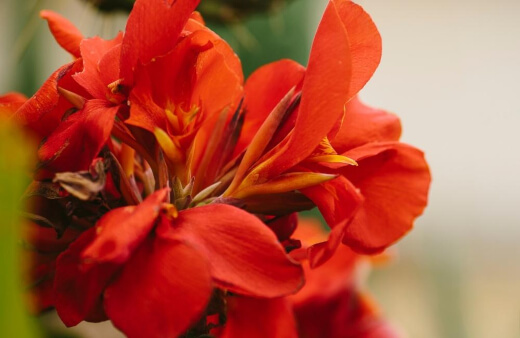
The exotic and tropical Canna is a genus of 19 species of flowering plants. It is also the only genus in the family Cannaceae and is related to bananas and ginger. You might have guessed the family resemblance looking at the large paddle-shaped leaves that are green and bronze.
Canna lily is quite the flower factory, producing beautiful colourful flowers from late spring or early summer until the frost of winter. When most flowers can’t take the intense summer heat, that’s when canna lilies thrive.
Canna Lily Varieties
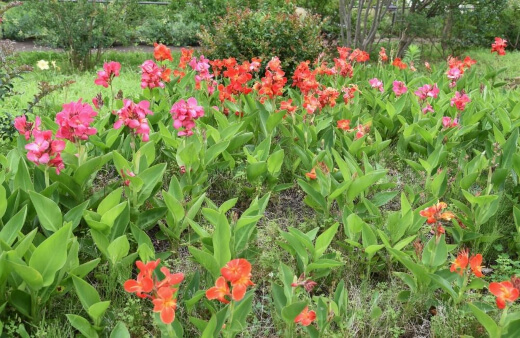
The name canna comes from the Celtic word “reed” or “canes”. Canna lilies became popular during Victorian times as garden plants. They were also grown in huge quantities in France, Germany, Hungary, India, Italy, the United Kingdom, and the United States.
The Canna species and cultivars enjoy temperate and subtropical areas and are widely grown in the garden. As we read earlier, there are about 19 species occurring in wild form.
The species were categorised by two taxonomists - Paul Maas from the Netherlands and Nobuyuki Tanaka from Japan, and this happened in the last 30 years.
Both Maas and Tanaka reworked the number of species from the 50 to 100 species that were previously known. Let’s have a look at some of the species of the canna lily:
Canna coccinea

Source: architecturalplants.com
Hailing from Northern Argentina, this species shows off raspberry red flowers, with orange or red stamens. The leaves are a deep green and the plant grows to a height of 2 metres.
Canna compacta
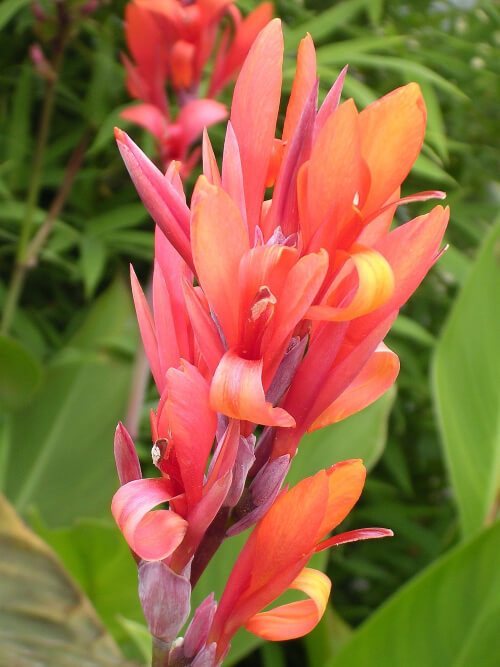
Source: en.wikipedia.org
The C. compacta originated in Southern Brazil and Northern Argentina. You’ll recognise it from its dark orange-red flowers that stand upright.
The leaves are a lush green and medium-sized. This species can reach a height of 2 metres.
Canna discolor

Source: gardentags.com


Get Your Free Guide:
Master Growing Australian Natives eBook
A Must Have Complete Guide for Every Australian Garden
Get Your Free Guide:
Master Growing Australian Natives eBook
A Must Have Complete Guide for Every Australian Garden
‘Brick Canna’ originated in Northern Argentina and can grow to a height of 3 metres. It's lovely flowers are red, or hues of peach and white.
Canna flaccida
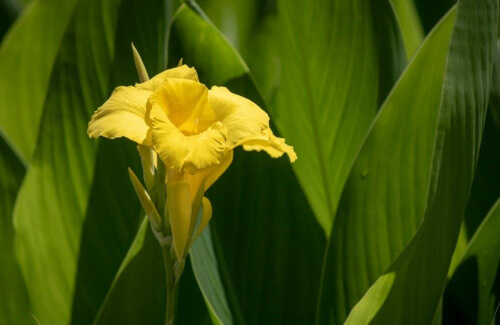
The C. flaccida is native to the wetlands of southeastern USA. Reaching a height of 1.5 metres, it has large, slightly perfumed, yellow flowers and leaves that are narrow and a blue-grey colour.
Canna glauca

Straight from the wetlands of tropical America comes this species with delicate flowers that are either pale yellow or pale orange. Similar to the Water Canna, the leaves are blue-grey and the plant grows to a height of 1.5 metres.
Canna indica
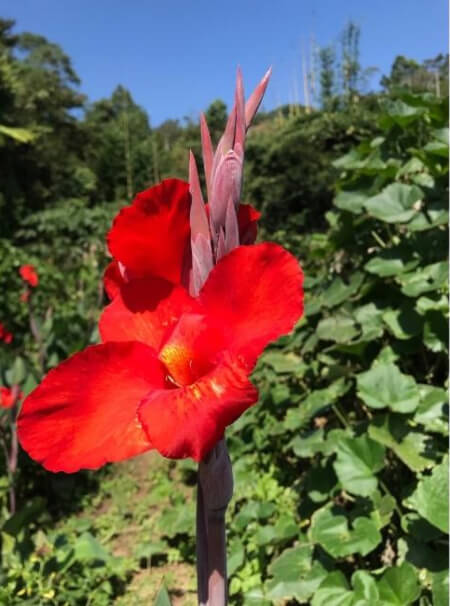
The South-eastern USA originated the C. indica, which grows to a height of 0.5 to 2.5 metres. Its flowers are magenta, scarlet and bright yellow, with leaves in shades of blue to burgundy, bronze-green, and blue-grey.
Canna iridiflora
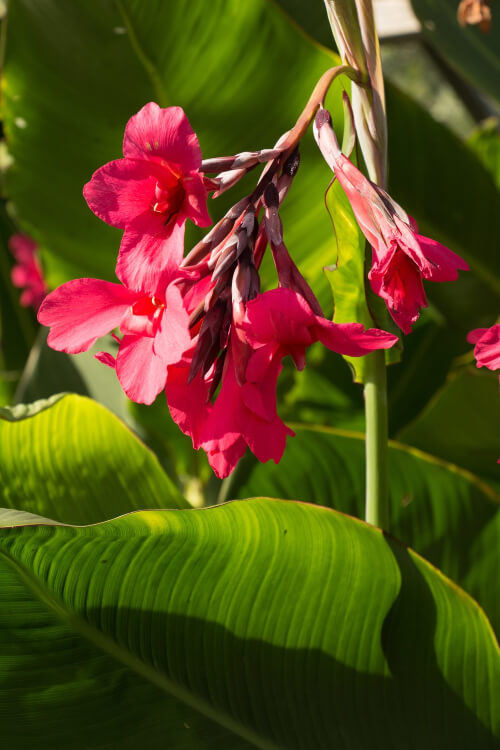
Source: avonbulbs.co.uk
Hailing from Peru, Columbia and Costa Rica, this species has large hanging flowers in shades of pink to red. It has large green leaves and the plant can reach a height of 5 metres.
Canna jacobiniflora

Source: en.wikipedia.org
Another species from the wetlands of tropical America, this has scarlet and orange flowers, and reaches a maximum height of 3 metres.
Canna jaegeriana
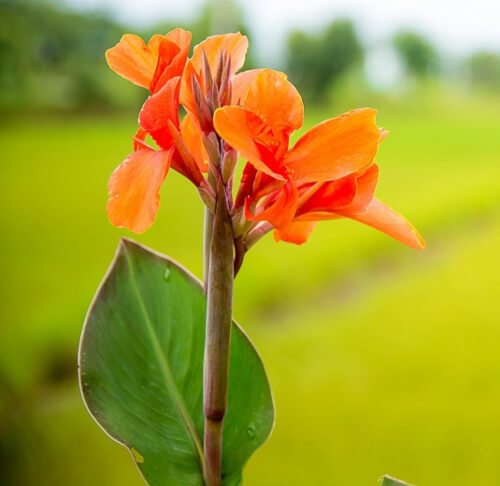
Source: quintadosouriques.com
South America and the Caribbean were the first home to C. jaegeriana. The flowers are usually curved and small, with an orange colour, and the leaves are very large with an oblong shape. This species can reach a height of 5 metres.
Canna liliiflora

Source: palmtalk.org
The Scented or White Canna originated in Peru and Bolivia. The leaves are oblong and very narrow, tinged with green. The flowers are long and smell like honeysuckle. This species can grow to a height of 3 metres.
Canna paniculata
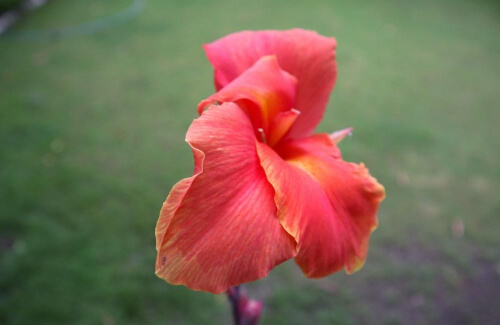
This species is native to Southern Mexico, Costa Rica, and tropical South America. The leaves have no stalk and the flowers appear in shades from red to yellow. C. paniculata grows up to 5 metres in height.
Canna patens

Source: plantsmap.com
Native to Northern Argentina, this species has flowers with mostly red petals and a thin yellow outline. The leaves are small and the plant reaches a height of 1.5 metres.
Canna speciosa
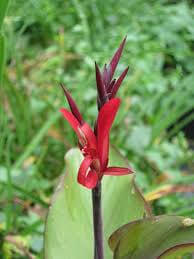
Source: johnjearrard.co.uk
Native to tropical America, C. speciosa has flowers with 2 colours, and shows off lovely scarlet petals. The large leaves have no stalks and arch over. This species grows to a height of 2 metres.
Canna tuerckheimii
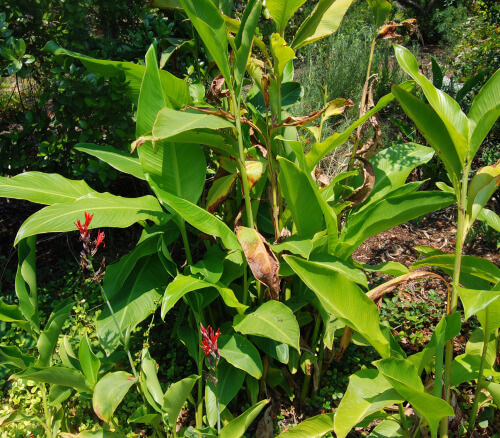
Source: tradewindsfruit.com
This particular species is native to Belize, Costa Rica, Guatemala, Honduras, Mexico, Nicaragua, Panama, Colombia, and Ecuador. Its flowers are orange-red, with large green leaves. C. tuerckheimii can reach a height of between 4 and 5 metres.
Canna amabilis
This species is native to Northern Argentina (Chaco) and reaches a height of 2 to 4 metres. The flowers are a deep crimson red to pale yellow colour, and they have many seeds. The plant has large leaves that are arranged in spirals.
Canna bangii
This species is native to Peru and Bolivia and boasts flowers that are orange-red and about 4-7 cm long. The C. bangii grows to a height of 4 metres.
Canna pedunculata
Canna Buekii Weinm hails from Southeast Brazil and grows to a height of 2.5 metres. It has small, yellow and upright flowers, and its narrow leaves can be green or blue-grey.
Canna coccineaHailing from Northern Argentina, this species shows off raspberry red flowers, with orange or red stamens. The leaves are a deep green and the plant grows to a height of 2 metres. |  Source: architecturalplants.com |
Canna compactaThe C. compacta originated in Southern Brazil and Northern Argentina. You’ll recognise it from its dark orange-red flowers that stand upright. The leaves are a lush green and medium-sized. This species can reach a height of 2 metres. |  Source: en.wikipedia.org |
Canna discolor‘Brick Canna’ originated in Northern Argentina and can grow to a height of 3 metres. It's lovely flowers are red, or hues of peach and white. |  Source: gardentags.com |
Canna flaccidaThe C. flaccida is native to the wetlands of southeastern USA. Reaching a height of 1.5 metres, it has large, slightly perfumed, yellow flowers and leaves that are narrow and a blue-grey colour. |  |
Canna glaucaStraight from the wetlands of tropical America comes this species with delicate flowers that are either pale yellow or pale orange. Similar to the Water Canna, the leaves are blue-grey and the plant grows to a height of 1.5 metres. |  |
Canna indicaThe South-eastern USA originated the C. indica, which grows to a height of 0.5 to 2.5 metres. Its flowers are magenta, scarlet and bright yellow, with leaves in shades of blue to burgundy, bronze-green, and blue-grey. |  |
Canna iridifloraHailing from Peru, Columbia and Costa Rica, this species has large hanging flowers in shades of pink to red. It has large green leaves and the plant can reach a height of 5 metres. |  Source: avonbulbs.co.uk |
Canna jacobinifloraAnother species from the wetlands of tropical America, this has scarlet and orange flowers, and reaches a maximum height of 3 metres. |  Source: en.wikipedia.org |
Canna jaegerianaSouth America and the Caribbean were the first home to C. jaegeriana. The flowers are usually curved and small, with an orange colour, and the leaves are very large with an oblong shape. This species can reach a height of 5 metres. |  Source: quintadosouriques.com |
Canna liliifloraThe Scented or White Canna originated in Peru and Bolivia. The leaves are oblong and very narrow, tinged with green. The flowers are long and smell like honeysuckle. This species can grow to a height of 3 metres. |  Source: palmtalk.org |
Canna paniculataThis species is native to Southern Mexico, Costa Rica, and tropical South America. The leaves have no stalk and the flowers appear in shades from red to yellow. C. paniculata grows up to 5 metres in height. |  |
Canna patensNative to Northern Argentina, this species has flowers with mostly red petals and a thin yellow outline. The leaves are small and the plant reaches a height of 1.5 metres. |  Source: plantsmap.com |
Canna speciosaNative to tropical America, C. speciosa has flowers with 2 colours, and shows off lovely scarlet petals. The large leaves have no stalks and arch over. This species grows to a height of 2 metres. |  Source: johnjearrard.co.uk |
Canna tuerckheimiiThis particular species is native to Belize, Costa Rica, Guatemala, Honduras, Mexico, Nicaragua, Panama, Colombia, and Ecuador. The Canna’s flowers are orange-red, with large green leaves. C. tuerckheimii can reach a height of between 4 and 5 metres. |  Source: tradewindsfruit.com |
Canna amabilisThis species is native to Northern Argentina (Chaco) and reaches a height of 2 to 4 metres. The flowers are a deep crimson red to pale yellow colour, and they have many seeds. The plant has large leaves that are arranged in spirals. | Cell |
Canna bangiiThis species is native to Peru and Bolivia and boasts flowers that are orange-red and about 4-7 cm long. The C. bangii grows to a height of 4 metres. | Cell |
Canna pedunculataCanna Buekii Weinm hails from Southeast Brazil and grows to a height of 2.5 metres. It has small, yellow and upright flowers, and its narrow leaves can be green or blue-grey. | Cell |
How to Grow Canna Lily
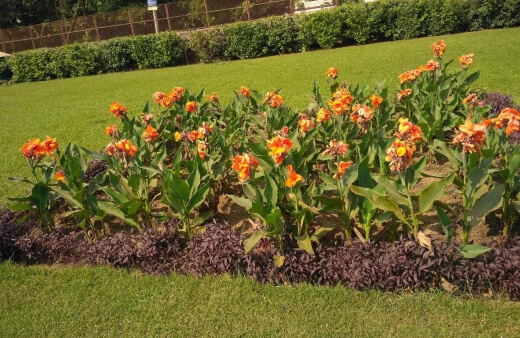
Propagating Canna lily from Seeds
Once the flowers of the canna lily have expired, you will notice that a cluster of seed pods develop. The pods can look a bit intimidating- they are green and spiky, and usually contain one to three seeds.
You should harvest the seeds once these seed pods become dry. When the pods open up to reveal the black seeds inside, it will be easy to squeeze them out. The seeds are big and easy to handle.
Collecting the seeds of the canna lily is the easy part – unfortunately the seed propagation is a little more complex. The seeds do not germinate when planted directly in the soil.
It has a tough seed coat that presents a bit of a challenge. The seeds will have to be prepared first by softening the seed coat. This will then assist the seed to germinate.
The seed propagation process includes:
- Soaking
- Heating
- Scarification
It can take a few tries to get the process right so don’t be discouraged, and germination usually takes one to two weeks.
Soaking – Canna lily seeds need to be soaked in water for a minimum of 24 hours and lukewarm water is recommended. You can use any commercially available potting medium, make small holes and put in the seeds. Cover the seeds with the potting mix and water them.
Heating - Next, the container should be covered in plastic wrap and kept warm indoors. A constant temperature of 21-24°C is needed to kick start the germination process. You could also use a heating pad to maintain the temperature.
Scarification – A great way to encourage canna lily seed germination is to rub off a bit of the seed coat before planting. You can use a file or sandpaper to scrape off the seed coat.
Keep rubbing until you can see the whiteness of the endosperm. The seeds can then be planted without soaking, as water can easily bypass the seed coat. The container needs to be kept warm.
Canna lily is a monocot – this means just one seed leaf will emerge first. When the seedlings are taller than 15cm they can be transferred into pots.
Where to plant and companion plants
Canna lilies are perfect to create a tall border and work just as well in narrow spaces. You could have many large patio pots filled with these super bright flowering beauties, or add some interest near water features where the canna lily will happily thrive.
In terms of companion plants, you can mix canna lilies with grasses, lantana, zinnias, snapdragons, elephant ears, salvia and periwinkles.
Planting Canna lilies

Canna lilies are often referred to as a bulb although they are not a true bulb. They multiply beneath the soil from an extension of the stalk called a rhizome.
Before you begin planting, you want to loosen the soil to a depth of 30 to 38 centimetres, then mix in a 5 to 12 centimetre layer of compost.
Dig a hole 5 to 8 centimetres deep and put the rhizome in the hole, with the eyes up. Cover the rhizome with 2.5 to 5 centimetres of soil, tap it firmly and water well. Remember to space the rhizomes 30 centimetres to 1.2 metres apart.
You want to plant outdoors in late spring and early summer and the soil temperature must be 15°C or warmer. Not sure how to measure soil temperature?
You can dig a small hole and insert an old-fashioned mercury thermometer into the soil. You could also buy a soil thermometer at a nursery or hardware store.
If your area doesn’t experience particularly harsh winters, your canna lily can be left in the ground all winter. In colder areas, you would need to dig up the rhizomes in late autumn.
If you live somewhere with a moderate temperature, you can add a layer of straw or leaf mulch to protect your Canna lily.
Caring for Canna lily
Since canna lilies are exotic and tropical creatures, they need lots of sunshine and fertile, moist soil.
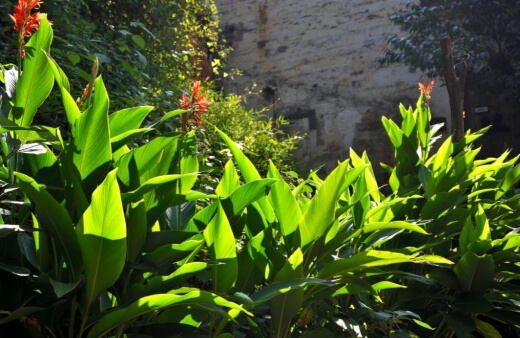
Light
A position in full sun is best, but the canna lily can handle partial shade. Choose an area to plant that gets at least four hours of direct sunlight. Morning or afternoon sun is the best.
Speaking of light, outdoor solar lights are a great option to brighten up your garden so you have more hours to enjoy its beauty. Here is our Australian buying guide for the best solar lights for 2025.
Watering
Canna lilies are slow to show signs of new growth and they don’t need much water until you start seeing signs of growth. It can take up to three weeks for canna lilies to sprout.
Once the sprouts appear, you can water at least once a week by slowly soaking the area around the roots. During the hottest weeks of the summer your canna lily will be very thirsty.
Give the plant a soaking drink of water every other day. You’ll notice that the full foliage colour develops when the days are warmer. If you’re experiencing a dry spell, you can water freely.
What Fertiliser to Use
Here’s some good news. Canna lilies are not fussy when it comes to fertiliser. In fact, these beauties will easily bloom all summer without much effort on your part.
If you do want to give your plant an extra boost, you can apply a 5-10-5 or 10-10-10 fertiliser in the spring and then twice more during the growing season.
Fish emulsion fertiliser is a little higher in nitrogen, but is a great organic option for feeding your canna lily. Higher nitrogen fertilisers have been known to increase the average height of canna lilies.
Rose food or tomato food also works wonders for these plants. It’s a good idea to keep a thin layer of mulch around the plant to lock in moisture as well.
Maintenance and Pruning Canna Lilies
As the flowers die off, it’s a good idea to remove the dead blooms to promote continued flowering. Once a flower stem has been deadheaded a few times and has stopped producing flowers, you can cut the flower stem and any foliage attached.
This helps other canna lilies in the surrounding area to get more light and flower themselves. You can cut back to 10 centimetres in late autumn to make way for the next spectacular display in summer.
When and How to Dig up Canna Lilies

You want to dig up your canna lily after the leaves have become yellow or died back, or been killed by frost. You’re going to start by cutting back all of the foliage 5 to 8 centimetres from the top of each rhizome.
Dig up the roots about 30 centimetres away from the stem so that you don’t damage the rhizome. Using your hands, you’re going to gently loosen the soil and lift out the clump. Shake off the dirt and cut off the foliage.
You’re now going to divide the clumps into 3 to 5 rhizomes. It’s a good idea to cure the bulbs for a few days to strengthen them and make them more resistant to rot. A garage or cupboard is a good place to cure the bulbs.
Next, you’re going to wrap the individual bulbs in newspapers or paper bags with a small amount of dry growing medium. You can use something like peat moss which absorbs moisture and prevents rot.
The bulbs should not touch each other. You can store the canna lilies over the winter in a dry place that doesn’t drop below 4°C, like an attic or basement.
You’ll need to check on your bulbs a few times over the winter to make sure they don’t dry out. You can sprinkle them with sand or peat moss as needed. If you do find rot, you can trim away the affected piece.
(We used to advocate for peat/sphagnum moss. But, recognizing its environmental impact, we've transitioned our guidance toward eco-conscious alternatives that offer comparable or better benefits. Check out our informative guide to learn more about peat moss and its substitutes.)
Unfortunately there will always be some bulbs that don’t make it, no matter how well you care for them. About 80% of them survive.
Your canna lilies can be replanted outside or moved outside when the nighttime temperatures remain above 10°C. When you do replant, make sure that each divided piece has at least one node.
This is where new leaves will grow from. You can then plant them 10 to 13 centimetres deep and 30 to 1.2 metres apart and you can expect them to bloom in about 10 to 12 weeks.
Pests and Diseases of the Canna Lily
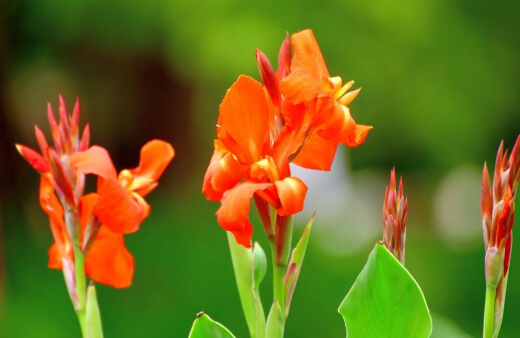
Canna lilies don’t really struggle with disease in general. If they become too wet or overcrowded, then the plant could be affected by the following:
Rust
This is a type of plant disease that is spread by fungal spores through air, and sometimes water. Increased humidity of the air surrounding the plant, combined with leaves that are wet for long periods creates a breeding ground.
You would notice large rusty patches on your plant. The rust can be really hard to get rid of. You would need to first remove the affected plant parts to avoid spreading, and then treat with either a copper-based fungicide, alternative biofungicide, or sulphur-based product.
Fungal Leaf Spot
A leaf spot is a discoloured and diseased part of a leaf, caused by a fungal, bacterial or viral plant disease. It can also be caused by injuries from insects or environmental factors.
You would need to prune and remove affected leaves first. Follow with a frequent treatment of neem oil or another fungicide. You want to avoid getting water onto the leaves as the plant recovers.
Bacterial Blight
Bacterial blight is caused by bacteria which survives in diseased stem tissue, plant debris, and soil. It can be spread by insects and on pruning tools, but mostly it is spread by wind and rain.
Likewise, canna lilies don’t often have issues with pests. Caterpillars could be found munching on the leaves and other unwanted garden guests include slugs, snails, and spider mites.
It’s worth noting that because some of these plants have large soft leaves, it’s a good idea to position them out of the wind so they don’t get damaged.
Other unwelcome pests that you might be dealing with in your garden are mosquitoes. We’ve got some tips on how to get rid of mosquitoes, using the best zappers and traps.
Canna Lily Frequently Asked Questions
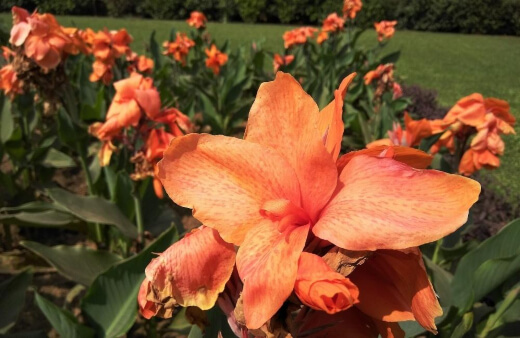
Does the canna lily attract any birdlife?
The bright flowers are known to attract hummingbirds.
Is the canna lily a true lily?
The canna lily is in fact unrelated to true lilies.
What is the canna lily used for?
The rhizome of the plant is rich in edible starch and therefore has many uses in agriculture. The stems and leaves are used as cattle feed. The shoots are edible and can be eaten as a vegetable.
The Canna lily seeds can be added to tortillas for extra flavour, and these seeds can also be used as beads in jewellery making.
Is the canna lily ever given as a traditional gift?
Canna lilies are a popular choice of gift for Father’s Day in Thailand.

Enhance Your Garden with the Vibrant Allure of Canna Lily
The canna lily is lovely, useful and colourful. Exotic and tropical, there are many varieties to choose from, and the plant is low maintenance, non-toxic and good for indoor or outdoor life.
The excitement of seeing canna lily's gorgeous blooms arrive in such stunning colours, will brighten your day and your home.
Published on March 20, 2022 by Maisie Blevins
Last Updated on December 23, 2025




